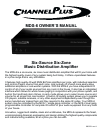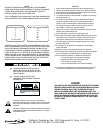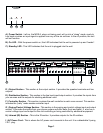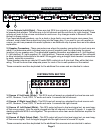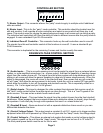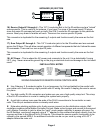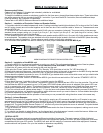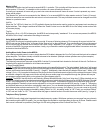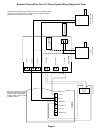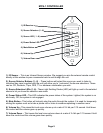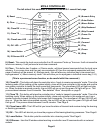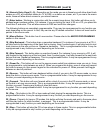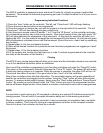
ZONE CONTROLLERS
1 8
OUT
1 81 81 81 81 81 81 8
IN123456
MASTER INDIVIDUAL ZONES
CONTROLLER SECTION
7.) Master Output - This connector allows the party mode to apply to multiple units if additional
units are added.
8.) Master Input - This is for the party mode controller. This controller should be located near the
unit and sources. It will override all zone controllers and select a source which will then play in all
zones. This mode is used for playing the same background music in all zones such as during a party.
The individual wall controllers still have the ability to select a different source after the party mode is
engaged. It uses a standard 8 pin RJ-45 connector.
9.) Individual Zone #1 Controller - This connector hooks up the wall controllers used in zone #1.
The signals from this wall controller control all the functions in zone #1. It uses a standard 8-pin
RJ-45 connector.
This connector is duplicated for the remaining 5 zones and function exactly the same.
PAGING/VOLTAGE CONTROL SECTION
10.) Audio Inputs - This is an audio sensing circuit and accepts the signal from an external phone
system, or a pre-amplified microphone (i.e.: a mixer output), that has the capability of sending a page
signal from the master phone unit. The signal from this phone system will mute whatever source is
playing in all zones and allow the person speaking to page into all zones simultaneously. When the
signal is disengaged, the music will return to the previous level. Even zones that are not currently
on will open and allow the announcement to be made. Inside the unit is a master DIP type switch
which allow the installer to turn off the paging and doorbell override. This is especially suited for a
nursery. Pin 1 is for signal and pin 2 is for ground.
11.) Switch Inputs - This input is designed for older systems like intercoms that require a push to
talk latch mode contact before the audio signal can pass through. This is a hard bypass of the
audio sources. This can act as a whole house mute as well.
12.) Doorbell A Input - This input takes the signal from the contact closers from the front doorbell
transformer. When engaged, the source signal mutes and a distinctive chime (on board) plays through
the speakers. It will even play through zone speakers that arent on unless locked out.
13.) Doorbell B Input - Same as above but with a separate distinctive chime sound so you can
differentiate between the doors.
14.) Control Voltage Output - This output sends a constant 5 volt D.C. signal out to trigger ancillary
equipment when the unit is powered up. When the unit goes into the sleep mode, this voltage stops.
15.) Control Voltage In - This allows an external sub system that sends a control voltage output to
this system to power up the unit from the sleep mode. This signal can be from 5 to 12 volts D.C.
The front panel power switch must be on for this to work.
7
8
9
Page 3
SG
10 11
12
13 14
15
PAGE
A
B
DOORBELL STATUS
S G +5v G +5v G
AUDIO
INPUT
SWITCH
INPUT
UNIT
ON
TRIG
ON
SG



